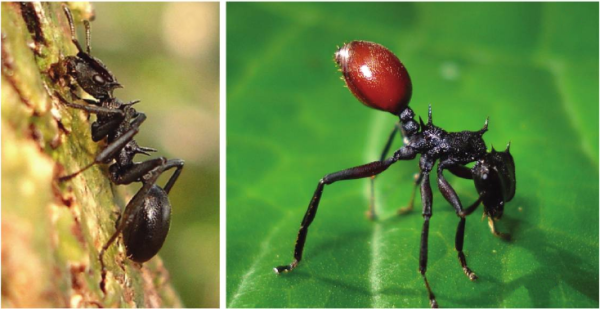Table of Contents
Group 6
Parasite-induced mimicry
Wiki site of the practical exercise of the III Southern-Summer School on Mathematical Biology.
Here you will find the exercise assigment and the group's products.
If you are a group member login to edit this page, create new pages from it, and upload files.
Final Presentation
Group
- Arestides Ferreira da Silva, Willian Talvane; Uppsala University, Sweden
- de Figueiro Santos, Joyce; Getulio Vargas Foundation, School of Applied Math, Brazil
- Millan, Cristiane Honora; São Paulo State University, Department of Ecology, Brazil
- Ornellas, Iago Silva; Federal University of Espírito Santo, Depart. Biological Sciences, Brazil
- Peres, Luciano; Federal Univ. Rio Grande, Graduate Program on Computational Modeling, Brazil
- Zahn, Thiago; University of São Paulo, Genetics and Evolutionary Biology Department, Brazil
Assistants
- Flávia Marquitti
- Vitor Rios
Assignment
While studying ant colonies on Panama's Barro Colorado Island, researchers found what appeared to be a new species of ant characterized by a red gaster (right picture above). Later, they realized that it was a Cephalotes atratus ant, which normally has black gaster (left picture above). However, when individuals from this species become infected with the worm Myrmeconema neotropicum their gaster changes to bright red. In many cases, parasites are able to manipulate host appearance and/or behavior to their benefit. When parasite transmission involves trophic interactions, modification of the intermediate host can increase the probability of transmission by predation to the definitive host. In this case, the modifications caused by the parasitic worm make the infected ants attractive to frugivorous birds, which apparently mistake their gasters for berries. The parasite life cycle is completed when infected birds pass worm eggs in their feces that are used as food in ant colonies 1).
The terminal part of the infected ants resembles a berry which increases the chance of predation by birds. Photograph by Steve Yanoviak.
Questions
First, the group should propose a model to describe this system. Additionally, there are different questions that can be addressed. The reviews listed bellow mention several questions that are relevant in the context of parasitic manipulation 2)3).


